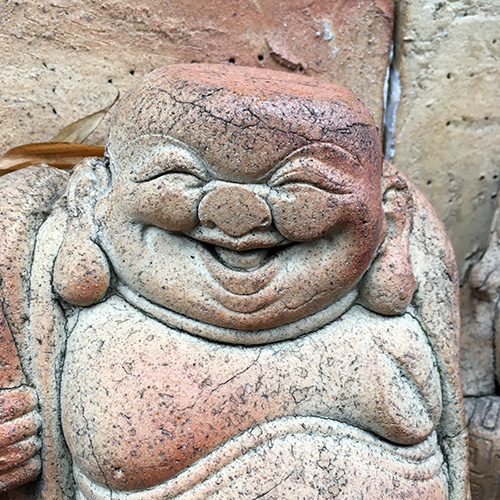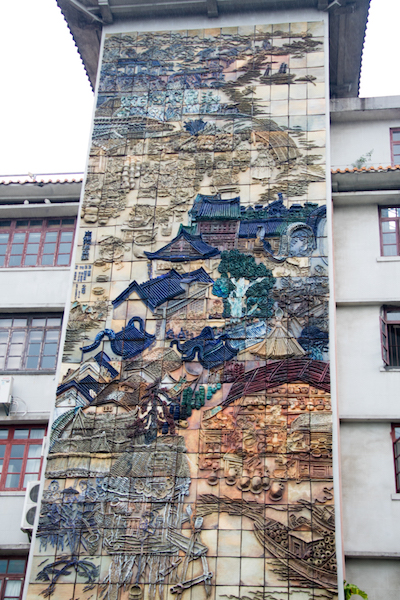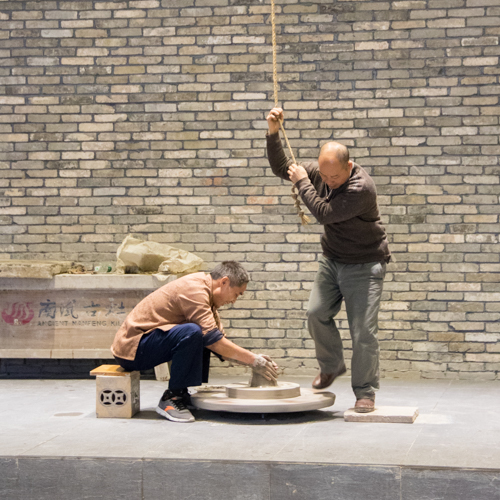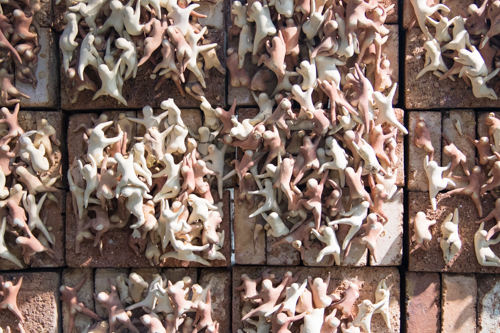“To give you a better impression of Zhuhai and surrounding cities, the College will organize one-day trips for all staff in this academic year.”
I signed myself (and my sister) up for the day trip to Foshan. The only thing I knew going in was that we’d be going to Foshan, which is near Guangzhou. I typically don’t do much research before these trips, mostly because I don’t have a lot of time, but also because I don’t always know where we’re going until after I’ve been there.

The day is cold, rainy, and windy. Ruth and I are dressed as well as we can be against the weather, but it’s not enough. As our bus arrives at the destination it starts to rain. We’re ushered outside to stand in the slow drizzle until they can provide us with wrist green bands. We huddle together under my small umbrella, shivering against the cold wind.
Small bald characters adorn the brick wall. The noses and bellies of some of the figures are pressed flat, as if they are leaning up against unseen glass. It’s an interesting and fun aesthetic.
The uneven brick courtyard is scattered with puddles and the bricks are a little slippery in places. Directly ahead of us are two wide stone stairs separated by hedges and bordered by a stone railing. The stairs lead to the top of a hill and what appears to be a small pagoda. To our left is a five story building sporting a large mural made up of smaller tiles with some sort of relief art. It portrays a city and what appears to be the clay manufacturing process.

Our guide leads us “indoors.” The stone buildings offer protection from the rain, but the air inside is just as chill as the outdoor air. We walk past displays of small clay figures. Birds. People. Some are on shelves and some are in glass cases. At the end of the hall is a small theater space with wooden benches. We sit as two men take the stage.

There’s a pottery wheel, maybe two or three so feet in diameter. The middle half is raised two or three inches from the outside ring. A rope hangs directly above it from the rafters. One man grabs the rope with his right hand and stands with his right foot on the wheel. He uses the rope to hold his body up while he uses his right foot to spin the wheel. He’s obviously done this many times, as he seems to keep the speed of the wheel consistent.
The second man sits and begins shaping a lump of clay as it turns. By now the entire audience has their cell phones out and are recording the event from two dozen different angles. I switch places with Ruth to give her a better view around the half standing Chinese people all eager to see for themselves. Over the course of two minutes the clay goes from a lump into a large bowl, a flat plate, a tall thin vase, and finally a wider pot. It’s impressive to watch. I wonder how common it was to have helpers spin the wheel by leg power like this.
Next we head back out into the rain to the kiln itself. They call it a dragon kiln because it winds up the side of the hill in the same way a Chinese Dragon winds back and forth. There’s a large pile of wood and a fire is going, but I’m still frozen. We wait in line to go up to the brick wall and touch it. It’s warm and I want to lay against it and sleep, but the mortar is crumbly and I don’t want to hold up the line.
This kiln has been operational for 500 years. It’s the oldest kiln in China that is still operating today. Foshan is known for ceramics and I wonder how much the processes has been industrialized over the years to meet the greater demand for tiles and dishes.
At the top of the hill there’s a tree which is growing near the top of the kiln. Despite the hot soil and presumed lack of nutrition, this tree still seems to be flourishing. It must be a lucky tree, for this reason. They have two footprints inset in the ground, providing you with the optimal place to stand in order to touch the tree and bring yourself good luck.

There’s a small table and a set of stools which have a wonderful white and blue glaze. The table almost looks like a tree stump. It’s difficult for me to tell what it actually is and with everything so wet and cold I don’t even consider walking over to touch it.
Our guide continues to tell us all about this place, entirely in Chinese. There’s a couple young women from UIC who occasionally fill us in on the more interesting things the guide is saying, but mostly we just look around.

When the tour completes we have about half an hour to look around on our own. Ruth and I find some interesting statues and walk through a small museum/workshop where a camera crew is setting up to interview an artist.
A brick wall is covered with small little figures trying to scale it. It gives me World War Z vibes. (Though I only know it from the movie trailer.)
Back in the wet courtyard we take some photos of a statue as we wait for the bus.

“He looks like that one guy from Zelda…” Ruth says to me.
“A Goron,” I reply. “Yes, he does. And I’m glad you said that, because I was thinking it, but it felt too nerdy to voice that idea.”
And if not a Goron, this guy definitely belongs in a Zelda game.
